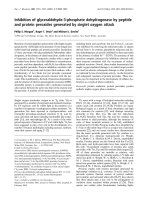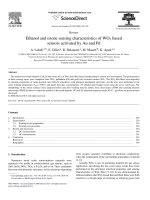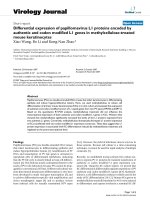Biogeochemical Variability of Vietnamese Coastal Waters Influenced by Natural and Anthropogenic Processes
Bạn đang xem bản rút gọn của tài liệu. Xem và tải ngay bản đầy đủ của tài liệu tại đây (3.67 MB, 10 trang )
Asian Journal of Water, Environment and Pollution, Vol. 4, No. 1, pp. 37-46.
Biogeochemical Variability of Vietnamese Coastal Waters
Influenced by Natural and Anthropogenic Processes
Nguyen Tac An
*
and Phan Minh Thu
Institute of Oceanography, 01 Cau Da, Nha Trang, Vietnam
!
Received January 15, 2006; revised and accepted November 5, 2006
Abstract: The paper focuses on an analysis of the main characteristics of Vietnamese coastal zones and their
biogeochemical cycles. Spatial and temporal variability in the distribution of chlorophyll, primary production, carbon,
nitrogen and phosphorus are discussed. Biogeochemistry depends on hydrodynamics, especially on the upwelling
from the seas, and on anthropogenic processes from the land.
Key words: Biogeochemical processes, coastal zone, Vietnam, chlorophyll, primary production, balance.
Introduction
More than 50% of a population of about 82 million live
in Vietnam’s coastal provinces that cover 41.30% of the
country’s total area (GDS, 2004). Their activities,
especially those that are related to food production such
as the development of aquaculture and fishing have
brought enormous pressure on Vietnam’s coastal
environment. For example, the accumulation of waste
from aquaculture has caused soil degradation, pollution
and eutrophication in water bodies in general and, red
tide blooms in coastal waters. Agricultural run-off and
inputs of domestic and industrial waste have further
contributed to changes in the distribution and behaviour
of elements and cycling of carbon and other nutrient
elements in coastal waters. Thus, not just the socio-
economic but also the regulatory functions of the coastal
waters are under threat. A better knowledge on the
processes involved and their interactions with the overall
structure and functioning of coastal ecosystems is a
prerequisite for developing management measures
towards the wise use and the protection of coastal marine
resources. This paper gives a brief overview of the
available information on the inputs from natural and land-
based human activities to Vietnamese coastal waters and
their influence on the biogeochemistry of coastal marine
systems.
The Main Characteristics of
Vietnamese Coastal Zones
Vietnamese Coastal Zones
Vietnam has a coastline of a 3260 km in length that is
very sinuous. As a result, many bays and lagoons have
been formed along the coast. On an average, for every
20 km of coastline, an estuary or a bay is found. The
landward boundary of Vietnam’s coastal zones from
coastal zone management programmes is set by the limit
beyond which there is no influence of tidal or marine
storms. The seaward boundary is set by the Exclusive
Economic Zone (EEZ) which is up to 200 nautical miles
from the coast. These boundaries vary from country to
country and are dependent on the specific local conditions
including geographical features and the legislative
framework (Table 1).
*
Corresponding Author
38 Nguyen Tac An
and Phan Minh Thu
Table 1: Examples of coastal area boundaries from coastal zone management programmes
Country or State Landward boundary Seaward boundary Comment
New Jersey/USA 30 m-30 km Tidal, bay and ocean state waters State Coastal
Programme
Rhode Island 200 feet from shoreward boundaries Territorial sea (three miles) State Coastal
of coastal features + specified actions excluding fishery Programme
likely to damage coastal environments
Hawaii All land except state forest reserves State waters State Coastal
Programme
Brunei All land and water areas 1 km inland From MHWM to 200 m isobaths ASEAN/US CRMP
from MHWM and areas inundated
by tides any time of the year
Indonesia Administrative and selected 60 m isobaths ASEAN/US CRMP
environmental units
Malaysia District boundaries Up to 20 km off shore to include ASEAN/US CRMP
islets off Mersing
The Philippines Boundaries of coastal municipalities 100 fathom isobaths ASEAN/US CRMP
+ inland municipalities with
brackish-water aquaculture
The Philippines Inner regions on marine dependant Outer reaches of fisheries resource ADB
systems or 1 km whichever is the systems which are associated with
greatest or influenced by the coast
Singapore Entire island Territorial waters and offshore ASEAN/US CRMP
islands
Thailand District boundaries Shallow continental shelf ASEAN/US CRMP
Costa Rica 200 m from MHWM n/a National Coastal
Programme
Law of the Marine and
Terrestrial Zone 6043
Sri Lanka 300 m from MHWM 2 km from MLWM URI CRMP. Coast
Conservation Act 1981
Ecuador Variable line depending of issues n/a URI CRMP
in five special management areas.
Vietnam Limit which is not impacted by tidal Up to 200 nautical miles, Institute of
or marine storms (about 100 km Economic Exclusive Zone Oceanography,
from coastline) Vietnam
Source: modified from Lunkapis, 1998
Like many other coastal states, Vietnam’s coastal zones
are also characterized by the presence of ecosystems such
as mangroves, coral reefs, sea grass meadows, which
provide goods and services to coastal communities. They
are also the preferred sites for urbanization. Coastal zones
thus play a major role in the national economy. There is
however enormous competition for land and sea resources
and space by various stake holders that result in conflicts
and the degradation of coastal ecosystems. Further
challenges to the coasts come from: (1) erosion and
siltation in coastal areas, (2) increasing population growth
(growth rate of population in 2004 is 1.44%, that means
population is 1.25 million people higher than in 2003)
and (3) the dangers of natural hazards.
Meteorological and Hydrologic Settings
Vietnam is located in the Indo-Chinese Peninsula and
covers tropical monsoon climatic zone. In the north,
annual rainfall is approximately 2,000 mm while
temperatures remain relatively constant—on average
between 25-35∞C. Most of the rainfall is between August
and November. In the south, the annual rainfall is about
1560 mm with most occurring between May and
November. The cities Ho Chi Minh in the south and Ha
Noi in the north represent major economic centres within
the coastal zone. Different from the north and the south,
rainy season in central Vietnam is from August to January.
The water balance of Vietnam given in Table 2 shows
that about 50% of the rainfall is removed as surface and
Biogeochemical Variability of Vietnamese Coastal Waters Influenced by Natural and Anthropogenic Processes 39
groundwater runoff. There are about 2345 rivers—all
longer than 10 km—discharging varying quantities of
freshwater, sediments, nutrients and metals to the sea,
account for a density of rivers of 0.6 km/km
2
(CMERSC,
2004, Table 3).
Because of the short distances between the sources of
most of these rivers and their receiving marine waters,
their impact on coastal seas is, in most cases, relatively
fast and because of the intense human activities in their
drainage basins, very severe. These important factors
need to be considered in studying the ecology and
biogeochemistry of the coastal zone.
Between July and November, Vietnam is hit by
random, violent typhoons that develop off the coast in
the East Sea. They typically hit the central and north
coasts and have been increasing in frequency over the
past few years. However, damage from them have
fortunately remained less severe relative to other regions
of SE Asia. But they do have an influence on marine
dynamics.
Socioeconomic Setting
About 25.4% of the population of Vietnam is urban and
the rest rural. Because of the rather slow rate of
urbanization, the growth of urban population has not been
significant (GDS, 2004). GDP (Gross Domestic Products)
in 2003 was 7.24% higher than in 2002, in which the
growth rate of agriculture forestry—aquaculture, industry
and the services sector contributed, 3.2%, 10.34%, and
6.57% respectively (GDS, 2004).
Agriculture and aquaculture sectors remain however
the major sectors affecting directly and indirectly the
coastal waters (Minh, 2003). Between 2002 and 2003,
there has been a slight reduction in the area where
agriculture is practiced because of the conversion of non-
productive agricultural land for aquaculture. Product-wise
however, there has been an increase in both agriculture
and aquaculture sectors.
The development of agriculture—aquaculture,
consumer products industry as well as mining and
maritime industry all have an effect on material runoff
Table 2: The components of water
balance in Vietnam
Components Volume (km
3
)
Rainfall water 640
Runoff water 313
Ground water 94
Surface water 219
Evaporation water 327
Source: CMESRC (2004)
Table 3: Annual discharge (tonnes year
-1
) of some rivers in Vietnam
Factor Red Thai Dinh river Cai River Han river Thu Bon Dong Mekong Vietnam
river Binh (Khanh (Khanh (Da Nang river Nai river
river Hoa Hoa City) (Quang river
province) province) Nam)
Catchment 298050 28200 10590 47280 830780
area (km
2
)
Runoff (km
3
) 200.00 46.26 0.679 2.535 5.676 14.0 50.5 573.1
TSS (10
6
) 114 0.062 0.150 0.194 160
COD 46400 45700 3236 99600 52000
NO
3
24602 10466 2475 62 79570 27941
NH
4
352
TN 706 3776 6602 8613
PO
4
14860 9888 36.3 16 10220 1470
TP 58 108 62 265
Fe 1029 2147 1782 2849
Mn 79 160 126 192
Zn 2015 3352 13 74 79 2921 12775 21739
Cu 2817 1100 6 22 37 62 500 1825 18084
Pb 730 154 0.4 3 16 16 102 190 2063
As 448 120 28 982 2407
Cd 118 164 128 1082
Co 254 20 503
Hg 11 16.5 25.6 <13 134
Source: National project KT03.07, 2001
40 Nguyen Tac An
and Phan Minh Thu
from land to the coastal waters and affect the ecology
and biogeochemistry of the coastal zones.
The Fluxes of Material Impact on Element
Distribution in Coastal Waters
Enhanced nutrient inputs from intensive aquaculture to
coastal waters have stimulated development of harmful
algal blooms. Seven species of harmful algae were found
in industrial shrimp farms in Do Son (Hai Phong)
associated with such algal blooms. In many cases,
environmental conditions in areas receiving discharge
from intensive aquaculture reveal drastic deviation from
allowed environmental standards in Vietnam. These have
also led to formation of hypoxia; for example, H
2
S
content in Nghe An and Thanh Hoa was found to be
1.7 mg/L indicating an oxygen content of <2.0 mg/L.
Furthermore, human activities and development of
industry also account for environmental pollution. The
annual solid waste production of Vietnam is higher than
15 million tonnes, in which more than 80% is domestic
wastes (MRNE, 2004, Table 4). Together with
aquaculture, waste from shipping and navigation has
increased the frequency of undesired impacts on coastal
water environments and destroyed ecological balances
in their ecosystems.
Oil pollution also appears to be a major problem in
Vietnamese waters. According to CMESRC (2004), the
average annual discharge of oil to the sea from Dong
Nai river system is 2.7–3.3 × 10
3
tonnes, from Mekong
river systems it is 27.5–55.0 × 10
3
tonnes, and from Red
river system it is 7–8 × 10
3
tonnes. The total of oil
discharged to the ocean was about 17.65 × 10
3
tonnes in
2000 (CMESC, 2004). In addition, the Vietnam coastal
waters are touched by major Europe-Asia shipping routes
and are affected by the heavy traffic.
In addition, construction of dams for hydroelectric
power and irrigation purposes also have their impacts on
coastal seas. On the one hand, retention of sediments in
reservoir behind dams reduces the amount of sediments
reaching coastal seas and thus affecting hydrodynamic
systems and productivity in coastal waters (Milliman,
1997; Humborg et al., 1997; Ittekkot et al., 2000; Chen,
2000). Duc (2000) showed that building dams is an
unsustainable way of development causing changes of
ecosystem structures also within reservoirs behind dams
mainly due to changing nutrient and sediment inputs.
For example, with Hoa Binh reservoir near Hanoi, the
constructed reservoir led to a reduction of forest coverage
from 41% down to 17%; more than 167 million m
3
of
sediment were trapped , which otherwise could have been
discharged to lower catchments or to coastal waters.
Studies on the impact of changing river sediment
inputs on coral reefs have been scarce. In one such study,
An and Thu (2001) report that from November 29, 1998
to January 28, 1999, the coral reefs in southern part of
Nha Trang Bay were covered by 0.52 g of sediment cm
-2
with an estimated annual sedimentation rate of about 1.0–
1.7 cm year
-1
. This appeared to have led to the destruction
of the reefs. Similar processes are probably occurring
elsewhere along the coast.
Distribution of Elements and Biogeochemical
Cycles in Vietnamese Coastal Waters
The Chlorophyll and Primary Production
in the East Sea
There is strong spatial and temporal variability in the
distribution of biogeochemical entities in Vietnamese
coastal water. This related to the seasonality in material
fluxes from land as well as in the prevailing
Table 4: Assessment of wastes discharged into marine environment of main areas
Area Kind of Volume BOD COD TSS TN
waste (m
3
day
-1
) (kg day
-1
) (kg day
-1
) (kg day
-1
) (kg day
-1
)
Ha Long Domestic 8500
Industry 59000 10158 16455 334585 22535
Ha Noi Domestic 270000
Da Nang Domestic 44200 21879 38454 47515
Industry 9855 1350 3144 2188
Dong Nai Domestic 815205 107587 202773 87773 32832
catchments Industry 153851 24880 39666 37030 8487
Mekong Domestic 220312 109054 236835 236835 19828
Industry 19216 2632 6131 4266
Source: CMESRC (2004)
Biogeochemical Variability of Vietnamese Coastal Waters Influenced by Natural and Anthropogenic Processes 41
hydrodynamic conditions. This is best seen in the
distribution of chlorophyll and primary productivity in
the East Sea (Bien Dong) (Figures 1 and 2).
The chlorophyll content in the East Sea including
upwelling regions ranges from 0.01 to 3.00 mg/m
3
while
the primary production from 1 to 700 mgC/m
3
/day. These
values are higher than those available at the National
Oceanographic Data Centre (NODC, 2002). Generally,
chlorophyll-a content in coastal waters of the East Sea is
higher than in offshore areas. Higher values along the
coast are found in regions with large material fluxes from
land such as off the mouths of the Red, Mekong and
Dong Nai rivers and within some bays in central Vietnam
(Figure 1). The places with high chlorophyll-a content
are areas of high primary production (Figure 2).
Especially high concentrations of chlorophyll and
Figure 1: Distribution of Chlorophyll-a (mg/m
3
) in the East Sea during the Northeastern (left) and
Southwestern monsoon (right) seasons. (Source: National project: KC 09.02, 2004, unpublished).
Figure 2: Distribution of primary production (mgC/m
3
, day) in the East Sea during the Northeastern (left)
and Southwestern monsoon (right) seasons. (Source: National project: KC 09.02, 2004, unpublished).









